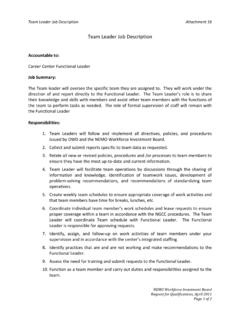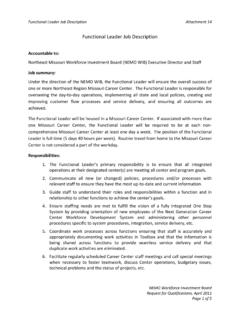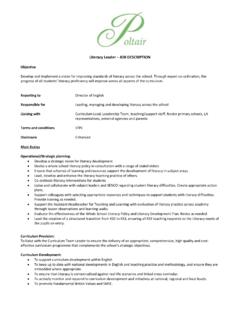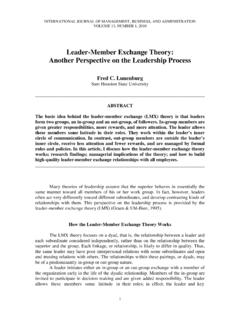Transcription of Giving and Receiving Feedback Leader Guide
1 Giving and Receiving Feedback Leader Guide Leader Guide Table of Contents BridgeSpan, Inc. 2003 Page i Rev. Date 9/23/2003 Table of Contents INTRODUCTORY MATERIAL Getting Started iii About This Guide iii The Program In Perspective vi Program Preparation vii Training At A Glance ix MODULES Self-Assessment 1 Giving Feedback 2 Receiving Feedback 4 Reviewing Your Assessments 5 Feedback 6 Reviewing Feedback ? 7 What is Feedback ? 11 How Do We Give Feedback ? 12 Redirection and Reinforcement 14 Communication Styles 17 What are Communication Styles? 18 Understanding Styles 21 Planning Feedback 25 Why Are You Providing Feedback ?
2 26 Setting the Environment 28 Table of Contents Leader Guide Page ii Giving and Receiving Feedback Identify Behavior and Performance Issues 30 Providing Examples 32 Identify Desired Results 33 Understanding Expectations 34 Controlling the Situation 35 Accepting Feedback 36 Delaying Feedback 37 Taking Time for Feedback 38 Useful Feedback 39 Detailed Feedback 40 Reinforcement 45 Redirection 47 Receiving Feedback 52 Two-way Process 53 Listening 55 Developing Your Feedback Skills 62 Leader Guide Getting Started BridgeSpan, Inc.
3 2003 Page iii Rev. Date 9/23/2003 Getting Started About This Guide What s the purpose of this Guide ? This Leader Guide provides a master reference document to help you prepare for and deliver the Giving and Receiving Feedback program. What will I find in the Guide ? This Leader Guide is a comprehensive package that contains the workshop delivery sequence checklists of necessary materials and equipment presentation scripts and key points to cover, and instructions for managing exercises, case studies, and other instructional activities. How is this Guide organized? This section, Getting Started, contains all of the preparation information for the Giving and Receiving Feedback program, such as learning objectives, pre-work, required materials, and room set-up.
4 Following this section is the Training At A Glance table. This table can serve as your overview reference, showing the module names, timings, and process descriptions for the entire program. Finally, the program itself is divided into modules, each of which is comprised of one or more lessons. A module is a self-contained portion of the program, usually lasting anywhere from 20 to 90 minutes, while a lesson is a shorter (typically 5-20 minute) topic area. Each module begins with a one-page summary showing the Purpose, Time, Process, and Materials for the module. Use these summary pages to get an overview of the module that follows. Getting Started Leader Guide Page iv Giving and Receiving Feedback About This Guide , continued How is the text laid out in this Guide ?
5 Every action in the program is described in this Guide by a text block like this one, with a margin icon, a title line, and the actual text. The icons are designed to help catch your eye and draw quick attention to what to do and how to do it. For example, the icon to the left indicates that you, the instructor, say something next. The title line gives a brief description of what to do, and is followed by the actual script, instruction set, key points, etc. that are needed to complete the action. A complete list of the margin icons used in this Guide is provided on the following page. TRAINER NOTE You may also occasionally find trainer notes such as this one in the text of this Guide .
6 These shaded boxes provide particularly important information in an attention-getting format. Leader Guide Getting Started BridgeSpan, Inc. 2003 Page v Rev. Date 9/23/2003 About This Guide , continued Graphic Cues Module Purpose Overhead Participant Workbook Lab Exercise Time Transition Flipchart Handouts Module Process Break / Lunch Group Activity Role Play Materials Required Audio Tape Case Study Instructional Game VHS To say Video Tape Assessment/ Quiz/Test Question & Answer Key points Computer/ CDROM Tool Welcome Getting Started Leader Guide Page vi Giving and Receiving Feedback The Program In Perspective Why a Giving and Receiving Feedback program?
7 Valid Feedback from others, when properly given, can make all the difference between success and failure on the job. Feedback provides us with information as to what is working and what is not working. We may look at Feedback as a bad thing, or something totally negative. However, when viewed in a different manner, you can see how Feedback is an opportunity to expand your understanding of the perception of others and use the Feedback as a tool for achieving positive results. Learning Objectives After completing this program, participants will be able to: Define Feedback Recognize communication styles Plan and deliver effective Feedback Receive and consider Feedback Recognize difficult situations Plan to improve Feedback skills Program Timing 4 hours Number of Participants Optimal 9 / Minimum 6 / Maximum 12 Leader Guide Getting Started BridgeSpan, Inc.
8 2003 Page vii Rev. Date 9/23/2003 Program Preparation Pre-Work Have students take self-assessment prior to attending class and bring their assessment to class. Required Materials leaders Guide Participants Guide Room Set-Up Classroom setup is most conducive with comfortable, group setting such as a u-shape table setup or round or oval table setting where each of the participants can clearly see each other and converse comfortably. Instructor Preparation Review the information in the leaders Guide . Getting Started Leader Guide Page viii Giving and Receiving Feedback Leader Guide Training At A Glance BridgeSpan, Inc. 2003 Page ix Rev. Date 9/23/2003 Training At A Glance Time Module Description 5 minutes Self-Assessment The student should take the assessment prior to attending the class.
9 20 minutes Feedback Participants will review three Feedback case studies and learn what Feedback is. Participants will also discuss redirection and reinforcement. 15 minutes Communication Styles Participants will review communication styles and how styles affect Feedback . 20 minutes Planning Feedback Participants will explore the actions involved in planning Feedback . 25 minutes Useful Feedback The participants explore the aspects of good Feedback . 20 minutes Receiving Feedback Participants will explore the two-way process of Feedback and learn that increasing the amount of information gained can help each achieve their goals. Training At A Glance Leader Guide Page x Giving and Receiving Feedback Leader Guide Self-Assessment BridgeSpan, Inc.
10 2003 Page 1 Rev. Date 9/23/2003 Self-Assessment Purpose The purpose of this module is to review and measure your current skills in Giving and Receiving Feedback . Time 5 minutes Process The student should take the assessment prior to attending the class. Materials Needed Participants Guide Self-Assessment Leader Guide Page 2 Giving and Receiving Feedback Giving Feedback For each statement, check rarely, sometimes, or often to indicate how consistently you use the described behavior in the workplace.











